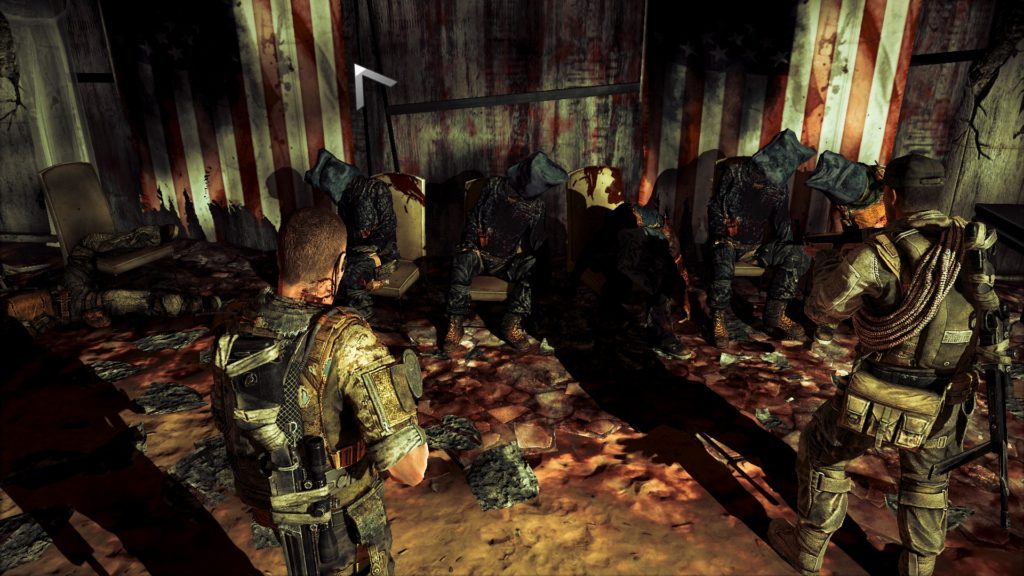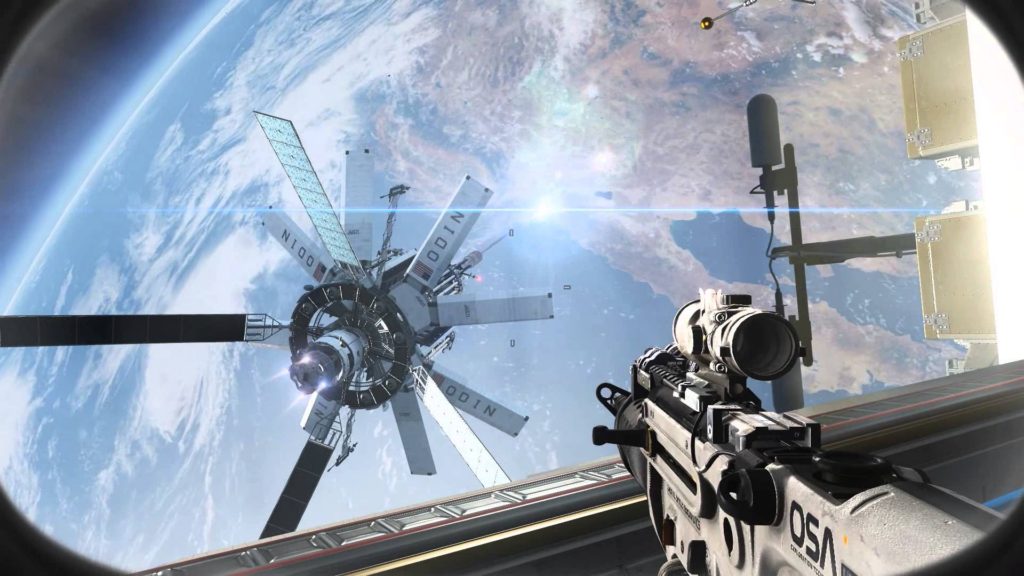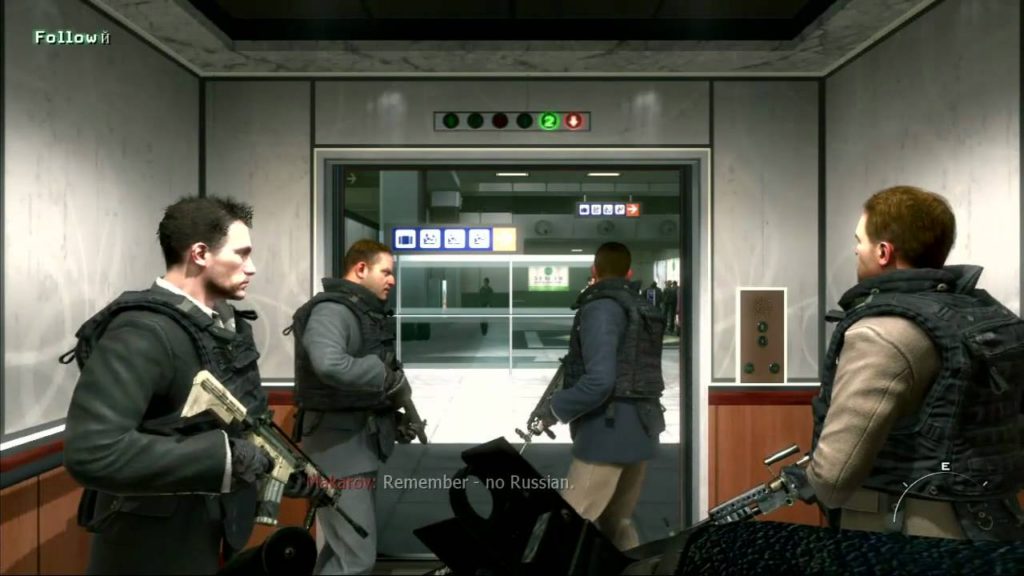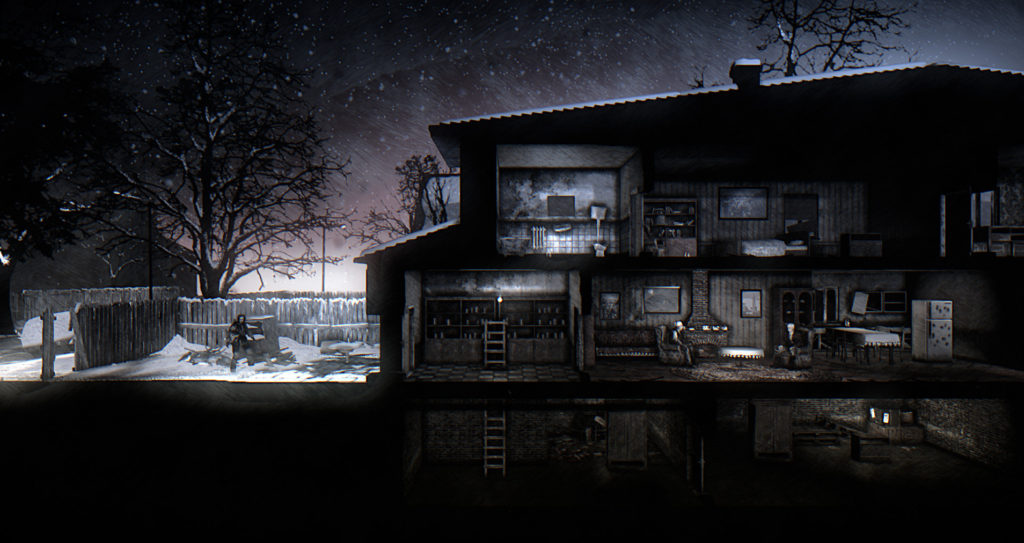In October 2008, chaos gripped Mumbai for four days as a series of coordinated bombings and shootings killed 164 people and injured hundreds more. All 10 attackers were highly trained and linked to a command center in Pakistan via VOIP technology. The command center, using TV and social media feeds as intelligence sources, gave the attackers a sixth sense in predicting security force’s movements and reactions. It was a grim portent of where we find ourselves in 2016—a place where the deliberate disruption and destruction of public spaces and networks is the latest tactic in modern warfare, a place videogames still fall short in depicting.
After events in Brussels, Paris, London, and San Bernardino, military spaces are no longer confined to designated battlefields placed out of sight and out of mind. Yet, the year of the Mumbai attacks, the closest videogames came to replicating these aspects of urban warfare was the destructible scenery of Battlefield: Bad Company (2008), and the spatial awareness and on-the-fly tactical planning of Full Spectrum Warrior (2004).
9/11 was the catalyst for this weaponization of the everyday, transforming the commercial flight network into a weapon of mass destruction and New York into a rubble-strewn hellscape. Everything since has gotten smaller and more diffuse as our enemies become interwoven into the cities and networks we surround ourselves with.
Post 9/11, videogames depicted virtual war zones as spaces firmly in our past, whether it was the bombast and grey skies of Call of Duty’s (2003) depiction of 1942 Stalingrad or the tightly scripted and artificial chaos of Medal of Honor: Frontline’s (2002) D-Day storming of Omaha Beach. These spaces were designed to depict combat as it was, not how it is. They could be shocking, they could show us horror, but our experience was caged with both the distance of time and constrictive level design. They gave us infantry charges against fixed positions on higher ground, amphibious assaults with hundreds of casualties, secret raids behind enemy lines, and tank battles across rolling countryside vistas. By dressing the levels in the certainties of history, level design was rigid and static. We could not stray or improvise. This is how it was.
In 2004, Full Spectrum Warrior tasked the player with moving a four-man combat team through the urbanized environs of a fictional Middle Eastern city. Rather than having direct control, the player merely directed the team to move to cover or lay down suppressing fire. Mistakes were punished, with a single bullet being capable of killing a squad member. Every architectural aspect became its own puzzle to be solved. In the player’s mind, the city was reduced to almost abstract terms, as alleyways became flanking opportunities and windows and doorways became potential ambush points.

Even though the game leaned on a fictional space for the player to move through, it still presented the modern city as an important factor in modern military thinking. The city and its architecture were something through which a force could focus its strength.
This idea of the city as a medium was one already discussed in military and urban theory. In his 2006 paper Lethal Theory, Eyal Weizman discussed how the IDF exploited the architecture of Nablus during its operations in 2002:
“Furthermore, soldiers used none of the streets, roads, alleys, or courtyards that constitute the syntax of the city, and none of the external doors, internal stairwells, and windows that constitute the order of buildings, but rather moved horizontally through party walls, and vertically through holes blasted in ceilings and floors.”
This tactic was one of necessity, after the IDF found entrances blocked with barricades or cement, and trenches filled with rubble or garbage. The ordinary avenues of approach were not open to them. Alleyways and windows were often booby trapped. They were off limits and alternative routes had to be found.
In 2009, Atomic Games came close to depicting aspects of Weizman’s Lethal Theory with the now-canceled Six Days in Fallujah. Leaning heavily on realism, with several combatants from both sides of the battle serving as consultants, environments would have played a pivotal part:
“According to the developers, destructible environments are critically important to telling the true story of the events in Fallujah, as the marines eventually learned to blow holes in houses (using C4, grenade launchers, air strikes and more) to surprise the insurgents waiting within. Referring to these moments as “combat puzzles,” Tamte claims that the destructible environments “change literally every aspect of how you play this game.”
During the First Battle of Fallujah, U.S forces surrounded the city and set up checkpoints. They cut off routes in and out of the city and subjected it to aerial raids and incursions by the Marines. This showed another aspect of urban military theory, with the city’s networks (invisible or otherwise) being key to its survival. In the introduction to his 2013 book, Out of the Mountains, counter-insurgency expert David Kilcullen described an argument he had with his friend over U.S operations in Baghdad:
“All that barbed wire, concrete barriers, checkpoints. You shut the city down. You stopped it flowing – put it on life support. You stopped people getting around to do what they had to do. You cut the violence, sure, but you did it by killing the city.”
Like Full Spectrum Warrior and the unreleased Six Days in Fallujah, Kilcullen sees the city as a medium through which a military force can wage war. The urban environment becomes more than just a backdrop, instead becoming a complex layer of systems that can be exploited or destroyed. This notion, employed by both sides of the conflict in Iraq, would soon mutate and take root in the cities of Europe.
In the interim, 2K Games threw their hat into the ring with Spec Ops: The Line (2012). Taking Heart of Darkness (1899) as its story model, it thrust the player into the shoes of Captain Walker, leading a recon team in search of a wayward colonel in a crumbling Dubai.
While Spec Ops distanced itself from any contemporary conflict it still tried something new with its environments and story direction. To begin with, the player moves through familiar looking environments, crouching behind destroyed vehicles and ruined buildings amid a landscape surrounded by never-ending desert. Later, Walker and his team conduct a white phosphorus mortar attack against approaching enemy hordes, only to realize they have inadvertently killed a large group of civilians in the process.

From here on in, Walker’s grip on reality loosens and hallucinations manifest themselves in the environment. The shattered glass and chrome of Dubai don’t adhere to the typical aesthetics of the modern combat zone, but instead act as a metaphor for Walker’s fracturing psyche. Changing from the traditional landscapes of the beginning, the surroundings soon turn into angled geometries and half-sunken structures.
The game plays with idea of the environment as something to be used, but does so in a fairly limited way. The desert begins as mere background, but as Walker descends deeper into the angled geometries and half-sunken structures of Dubai he finds nature has begun to reclaim the city. From this point on, Walker begins to use the environment in his fight. One example has him shooting the glass inside a large, cavernous room, allowing the desert sand to pour in and drown the assembled enemies. If man is the apex predator here, then nature is the great equalizer.
But while the environments veer slightly from the norm, the game presented a potential turning point for the military shooter in another way. It made the player consider the consequences of their actions. It revealed the horror of that oft-used term ‘collateral damage’ and externalized its protagonist’s fraying emotions onto the environment itself.
Usually the player is merely told the protagonist’s feelings through strained dialogue, but Spec Ops dared to be different by showing us Walker’s descent into madness by coupling it with his journey to the center of a ruined metropolis, linking the two together in a way mainstream military shooters haven’t gone near since. This promised a future where the genre asked the player to consider the effects of combat, not only on civilians but their military protagonists. In a genre predicated on high body counts and swathes of destruction it was something of an outlier.
Maybe this is why critics rallied behind the game, but players and sales were not so kind. Spec Ops is asking the player not only to question their actions in the game, but in every military shooter that came before. Additionally, if the player continues to play games of this genre after being confronted by the madness and trauma Spec Ops presents, what does that say about them?
Placed amid airbases and the destroyed ruins of Washington D.C, Call of Duty: Modern Warfare 2 (2009) had a chance to reconnect the most popular shooter series of modern times to some semblance of reality with the level “No Russian”.
The stage placed the player in the role of an undercover CIA agent taking part in a terrorist massacre at a Moscow airport. In terms of prescience it has some cachet. The game depicted a civilian space being used as a ‘soft target’ by terrorists, a tactic that has become pivotal to the plans of ISIS, their affiliates, and lone-wolf attackers. As the player moves through the level, civilians cry out, run, hide, cower, and spin as bullets cut through them.
However, the virtual space lacks context, emotional or otherwise. Up until this point, the game has the player moving through an occupied city and a Russian airbase, traditional settings for military shooters since their beginnings. The game would return to such settings throughout, giving the sense the ideas and issues raised by “No Russian” were ones the creators didn’t really want to pursue. The level, like others in the game, is one where a path has been decided for the player. The navigation of the physical landscape is as limited as the emotional and moral one. Shoot the civilians or don’t shoot the civilians, either way the level ends with the player being gunned down and betrayed. If the player chooses to shoot the terrorists they turn on them and the level ends in failure. The player is made to watch. There’s nothing the player can do but move through the environment and play their part.
One exception in the failure to depict military environments as a reconfigurable medium is Rainbow Six: Siege (2015). Eschewing single player for the most part, the multiplayer gives players a simple Attackers Vs Defenders set up. At the start of each round, the attackers have a small window of opportunity to uncover the defender’s location, while the defenders have a chance to fortify their position using barriers, reinforced walls, boarding up doors, etc.
Once the round begins, the player’s interaction with the architecture and surroundings can dictate the flow and outcome of the round. Walls, doors, ceilings, and floors are (almost) completely destructible by using breaching charges, grenades, or even the puncturing work of bullets over time. If a player has no clear sight to the objective or opposition then they can destroy the architectural barriers impeding them, deforming and recreating the environment to suit their needs.
This gives the game a constant source of tension. An attack can come from anywhere. Siege offers a filtered reflection of our times—where Brussels and Paris become temporary warzones with no place to hide.These tactics of infestation and destruction first brought to bear on cities like Fallujah and Nablus have now been brought to the West. But Siege’s levels fall short, portraying the same old environmental fallbacks such as compounds and anonymous factories. Only a few levels, “Kafe Dostoevsky” and “House,” come close to portraying the reality of combat in the modern metropolis. “House” is an urban space tucked away in the suburbs transformed into a tight, close quarters killbox, whereas “Kafe Dostoevsky” presents a high class restaurant in Moscow that has an air of authenticity about it after the Beslan school siege and the Moscow theater attack.
In the wake of the controversy surrounding the “No Russian” level, the Call of Duty games deviated from the present altogether, simultaneously shifting forwards into imagined futures and hurtling backwards into the murky depths of the Cold War.

This year’s Call of Duty: Infinite Warfare is the culmination of this line of thinking, taking the player far beyond the present and even Earth itself, venturing out into the cosmos and upping the pyrotechnics. Military spaces here are pure fantasy, portraying landscapes and buildings cribbed from science fiction and a future that may never come to pass.
The Battlefield series took a similar path. 2008’s Bad Company gave us fantastically destructible architecture, but never really utilized it in a way that encouraged tactical and lateral thinking. Further entries in the series doubled down on this idea while scaling the narratives into imagined East vs West conflicts based on Cold War thinking.
This year’s entry, Battlefield 1, is something of a contradiction. It gives us some of the most destructive scenery elements since Bad Company, enabling players to use weapons and vehicles to reconfigure elements of the environment to suit their tactics and needs. The only caveat is that parts of the levels (at least in the beta and closed alpha) are not destructible, taking the player out of tactical flow when their tank comes across the umpteenth indestructible farmhouse.
But, while Battlefield 1 brings the series closer to the modern face of war, it has also moved further away, changing up time periods for the first time since the series beginnings and placing the action firmly in the era of World War One. History has already given us the victors and losers for this conflict, stripping away any moral uncertainties the player may have. The context of the ethically grey war on terror remains as far away as it ever did.
In 2016, virtual war zones in both Battlefield and Call of Duty are separated from the present by the barrier of fiction and time. It could be argued Atomic Games’s insistence on leaning towards realism in Six Days in Fallujah is one of the factors in the game’s controversy and descent into development hell. Atomic Games described their game as a survival horror of sorts. It postulated a game that would show us the effects of war, as well as giving us a feeling of the panic and terror of urban combat in the modern era.
Other games, like This War of Mine (2014), Liyla and The Shadows of War, and Unmanned (2012) give the player a very different representation of war spaces. Far from the almost untouchable American mainland, these developers all hail from countries that have seen the effects of war on the environment firsthand. Also, being smaller operations means smaller budgets, which arguably means they can afford to take a risk on a more experimental and controversial game than bigger studios.
This War of Mine casts the player as a group of civilians attempting to survive in a battle-ravaged city. Drawing from the four year siege of Sarajevo, This War of Mine is a game of survival, not conquest. A majority of mainstream military shooters are grafted with an American perspective—they care about heroism and tell tales of victory. But the people behind This War of Mine, 11 Bit Studios, are from Poland and it shows in their game. The experiences of war between Europe and the U.S is notably different, with many buildings in Poland still bearing the marks of World War II to this day, the memory of those years is present and physical, not distant. Here, the environment saved lives, serving as a place of shelter and safety, however temporary.
It makes sense, then, that the bombed-out environment in This War of Mine is presented as something to be moved through cautiously, with potential enemies outnumbering and outgunning you. It also acts as a sanctuary, whether it’s the safe confines of your home base, or the shadows of a doorway that hides the player from a roving soldier. Survival depends very much on one’s familiarity with the intimate spaces of its bleak, dilapidated architecture.
Liyla and The Shadows of War has the player moving through a platformer representation of the Gaza Strip. Here, the environment is chaotic and ever changing, with the player avoiding hazards such as bombs and drones. As in This War of Mine, the player is reacting to the changes in the environment rather than being the force conducting them. Additionally, the creator, Rasheed Abueideh, is Palestinian, and clearly has an emotional stake in the events the game is depicting. He has gone on record as saying that Liyla is “not just a Game, it’s a case and call for help.”
Unmanned takes an even more outlandish route, putting the player in the shoes of a drone pilot. The game disconnects the player from the environment and the enemy below. It presents drone warfare as monotonous and emotionally draining, interspersed with snippets of violence, home life, and soulless karaoke sessions. While the creator, Paolo Pedercini, has no firsthand experience of drone warfare, the game comes from the perspective of wanting to inform, educate, and foster discussion on the topic:
“[A]t the time there was no public debate around CIA’s covert operations and issues related to unmanned warfare; only Der Spiegel and Wired’s Danger Room were talking about drone wars. My original idea was a kind of semi-playable art installation that simply reproduced the control room of an UAV juxtaposed with mundane conversations. It was meant to present something “invisible” in a cold, detached way.”
That Unmanned gives us one of the more realistic portrayals of a member of the military in videogames is telling. It raises the idea that it’s only when military shooters depict historical or fictional conflict that we are allowed to “play” in them. If they begin to broach the barrier of the present, then the idea of the player deriving enjoyment from something still bringing so much pain into the world begins to muddy the waters. This may be down to the player’s openness to admitting certain philosophies and ideologies over others. As Pedercini has also said:
“In general, you have to consider that the range of acceptable political ideas in Italy and Western Europe is wider [than in the US]: kids occupy high schools, workers actually go on strike, moms and dads march against unjust wars and so on.”
So things stay static, military shooters stay in their lane, and the player is told where to look and how to feel by the established continuity of history. War is something the player moves through but never fully experiences. Other genres that tackle war can go deeper. But in the military shooter, war is always something that happens somewhere else.


